The Skylake Core i3 (51W) CPU Review: i3-6320, i3-6300 and i3-6100 Tested
by Ian Cutress on August 8, 2016 9:00 AM ESTOffice Performance
All of our benchmark results can also be found in our benchmark engine, Bench.
Agisoft Photoscan – 2D to 3D Image Manipulation: link
Agisoft Photoscan creates 3D models from 2D images, a process which is very computationally expensive. The algorithm is split into four distinct phases, and different phases of the model reconstruction require either fast memory, fast IPC, more cores, or even OpenCL compute devices to hand. Agisoft supplied us with a special version of the software to script the process, where we take 50 images of a stately home and convert it into a medium quality model. This benchmark typically takes around 15-20 minutes on a high end PC on the CPU alone, with GPUs reducing the time.
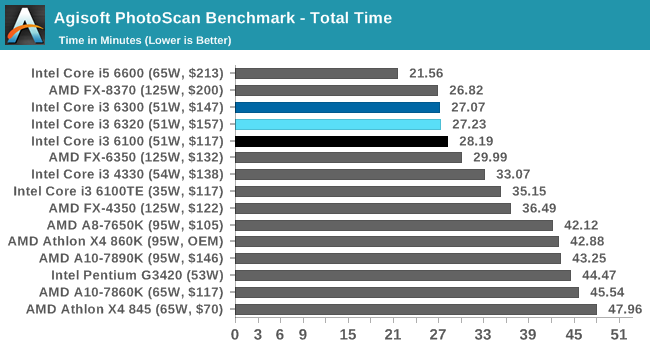
The different stages of Photoscan have different preferences for frequency and threads, but all the results are in Bench. In this case having threads matters, with the old 8-thread FX CPU barely getting ahead of the Core i3 parts. The i5 takes the lead, showing that having physical cores helps with cache management. This is further reinforced by our results staircase, which put the i3-6320 and i3-6300 at roughly equal timings but the i3-6100 almost 4% behind.
Cinebench R15
Cinebench is a benchmark based around Cinema 4D, and is fairly well known among enthusiasts for stressing the CPU for a provided workload. Results are given as a score, where higher is better.
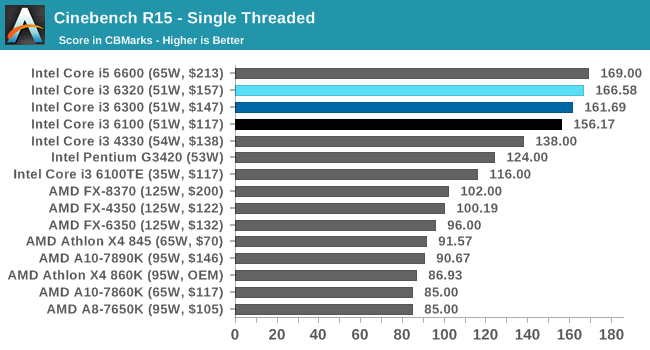
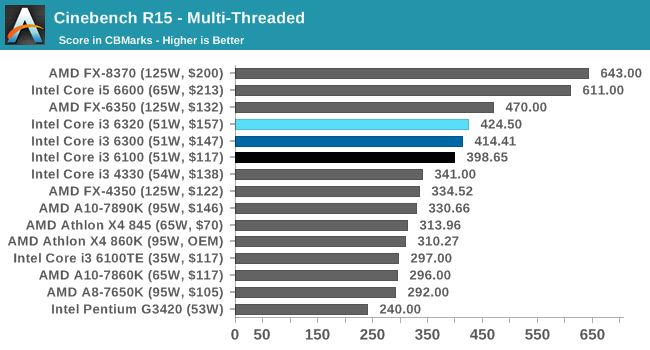
Cinebench eats threads, high IPC and high frequency for breakfast. In the single thread test, the high Intel IPC shines through, and our i3 parts sit in unison with AMD behind by up to 40%. In multithreaded land, the 6/8 thread FX processors go ahead of the i3s as expected, and our staircase slightly deviates for the i3-6100 showing that L3 cache creep is slowly coming in.
HandBrake v0.9.9: link
For HandBrake, we take two videos (a 2h20 640x266 DVD rip and a 10min double UHD 3840x4320 animation short) and convert them to x264 format in an MP4 container. Results are given in terms of the frames per second processed, and HandBrake uses as many threads as possible.
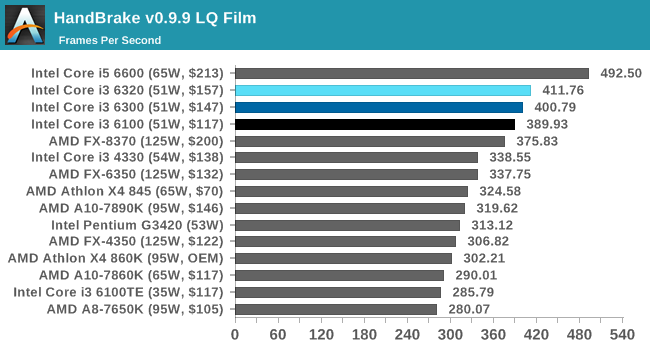
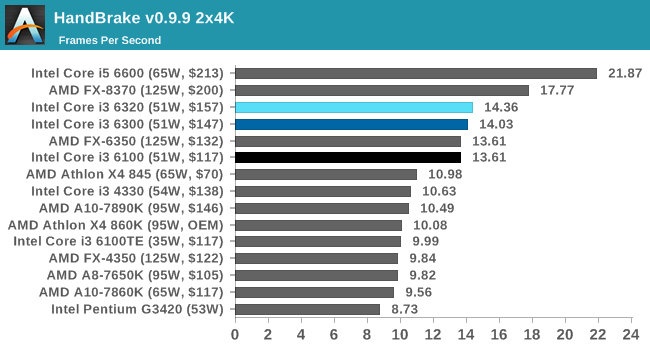
The high IPC of the Skylake parts makes a difference for the smaller frame conversion, while threads come into play for the larger resolution frames. In both cases, the regular staircase shows a lack of issues with the L3 cache differences, but it is interesting to see the X4 845 hot on the heels for the high resolution frames despite its cache arrangement. The FX-6350 sits on par with the i3-6100, showcasing the difference between a six-thread much older processor and a four thread latest process part.
Hybrid x265
Hybrid is a new benchmark, where we take a 4K 1500 frame video and convert it into an x265 format without audio. Results are given in frames per second.
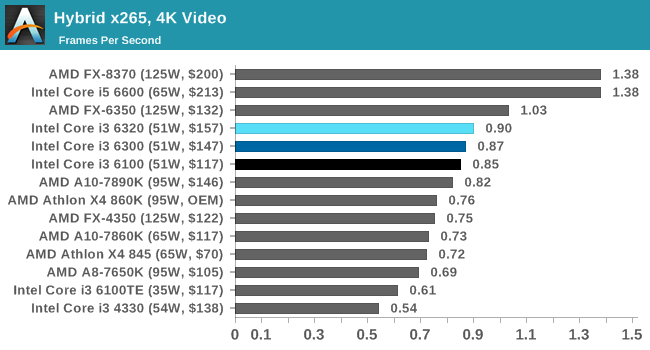
Hybrid is similar to HandBrake, and we again have a regular staircase.










94 Comments
View All Comments
Morawka - Monday, August 8, 2016 - link
It's still suprising to see it on a low end CPU. i didnt know the i3's had ECC, now i'm thinking of building a FREENAS box off of one of theseSamus - Tuesday, August 9, 2016 - link
You'd be surprised how many servers actually ship with i3's...those HP ML10's are incredibly common and I've seen a number of Lenovo SMB servers run i3's.The i3 is more than adequate for most small business servers unless they plan to run Hyper-V. Most other CPU intense services are cloud-based now (I personally think a business is crazy to maintain their own exchange server these days when Microsoft offers a $4/month/mailbox turn-key solution)
Basically all servers do now is run the domain and a few basic services like file sharing and routing. SQL, Exchange, even Hyper-V are all inexpensive Azure\Office365 services. It really comes down to who costs more, your IT guy, or Microsoft. Odds are, the IT guy. Unfortunate because I am one.
jardows2 - Monday, August 8, 2016 - link
Low end consumer CPU's. Intel likes the product segmentation between Xeon's and i5/i7. This is also why Intel forced the use of the "c" series chipsets for the Xeon processors. a Xeon E3-1240 v5 is about $30.00 cheaper than an i7 6700, with a higher base frequency, but slightly lower turbo frequency.Of course, this helps people who are wanting server grade, but only need low end processing power. A Pentium or an i3 would be a great home server chip, but i5 or i7 overkill. If you are wanting to use a higher-end production computer with ECC, you probably are looking at higher-end processors than i5 or i7 anyway.
However, AMD includes the support in all their AM3+ processors, and I believe in all their FM2 processors as well. Not every motherboard supports it.
sheh - Monday, August 8, 2016 - link
Yes, I was referring to non-server CPUs.But why is it on the i3? Not that I mind, but the surprising aspect and the problem is that it's not on i5 and i7.
Black Obsidian - Monday, August 8, 2016 - link
jardows2 covers that in his/her product segmentation reference.If you want ECC on the low end, Intel is happy to sell you an i3. If your needs are any higher, Intel wants to push you towards a Xeon (and C-series chipset), which IIRC are higher-margin parts than the i5 and i7, and happen to have gone through additional server-related validation.
satai - Monday, August 8, 2016 - link
I understand this concept but I still don't get why there are cheap ECC enabled i3s instead of more expensive (but still cheaper than 4C Xeons) dual-core Xeons...extide - Monday, August 8, 2016 - link
Yeah, that is kinda weird, you would think Intel would do that, and create even more segmentation, which is something they definitely tend to like to do.rhysiam - Monday, August 8, 2016 - link
My guess would be (and full disclosure... this an educated guess): at some point the market becomes too niche and the higher profit margins get lost to the additional costs of segmenting product lines, keeping different lines in stock, etc. The cheapest Xeon quad core on Newegg is already only $90 more than the cheapest i3. How much more could Intel actually charge for a dual core Xeon over the i3, the only benefit of which is ECC? Then they'd have to maintain a whole new product line, manage stock levels, etc. My guess is that for the relatively small number of customers pairing a dual core with ECC memory, it's just more trouble than it's worth.satai - Tuesday, August 9, 2016 - link
Thet sounds like a believable explanation.DanNeely - Monday, August 8, 2016 - link
What exactly is the point of the Core i3-6098P supposed to be? Compared to the equally priced I3-6100, it's slower, has a weaker GPU, and a higher TDP. On paper I can't see any reason to buy the former instead of the latter?